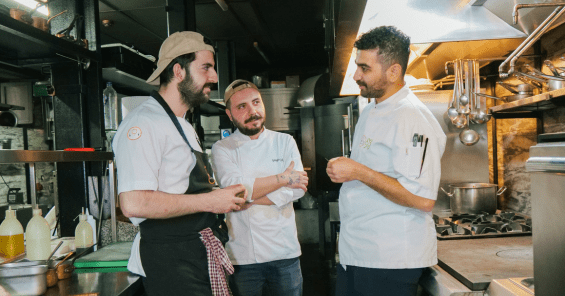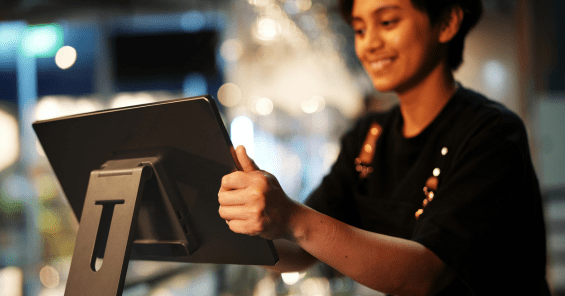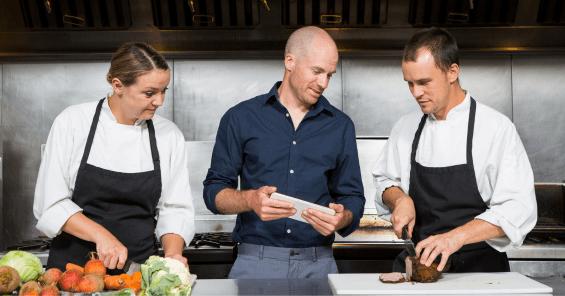

Thinking About Starting Your Own Restaurant? Check Out These Experts’ Advice Before You Begin
15 restaurateurs and industry experts advise on what it takes to run your own business and what to do before starting your own restaurant.
It’s no secret the U.S. restaurant industry took a big hit during the pandemic. Forbes points out that the industry is about 10 percent smaller than it was pre-pandemic. Starting a restaurant is a risky business, made riskier in the last few years by the COVID pandemic. That doesn’t mean, however, that opening a successful restaurant is impossible.Even through lockdowns, owning a restaurant didn’t mean automatic bankruptcy. Restaurants that could pivot to delivery and contactless takeout kept their doors open, so to speak, and kicked off a trend that experts project will continue to grow.And while supply chain disruptions and labor shortages are expected to persist into 2022, patrons are expected to increase their spending on eating out as vaccination rates rise, according to Deloitte.
How To Start And Grow Your Restaurant Business
Whether you're embarking on launching your first restaurant, opening a second (or third) location, or ready to turn your restaurant business into a franchise, this guide will help you make the smartest decisions possible for your business

The key to opening a successful restaurant will lie in a laser focus on your concept, operations, staff, and customers, as well as the flexibility to pivot when changes come at you.Some advice from seasoned professionals doesn't hurt, either. We’ve rounded up valuable advice from restaurateurs to consider as you plan your own restaurant.
Crystalize Your Brand Identity and Purpose
Think of your restaurant as having a personality of its own, and formulate a brand identity as well as a purpose. Involve your partners and staff, as well.
Create a direction, advises Matt Rolfe, entrepreneur, coach, speaker, and bestselling author of You Can’t Do It Alone: Focusing on People to Scale, Develop, and Lead Your Restaurant. “An owner or leadership team needs to sit together before they have conversations or have conversations with themselves about their team and where they’re going.”
Is your restaurant high-end and formal or casual and fun? Does it exist purely as a business that fills a hole in the market or will it be an integral part of the community? By answering these types of questions, you’ll be able to set a clear vision for your restaurant and your team.
Mark Canlis, co-owner of Canlis in Seattle, urges would-be restaurant owners to ask themselves the following questions as they put together their business plan.
- What’s the point of the company?
- Does the restaurant exist to make money?
- Does it exist for something else?
- What am I really doing here?
Alexandra Clark, founder of Bon Bon Bon in Detroit, advises restaurateurs to ask their employees the following questions, as well.
- Why does this restaurant exist?
- Why do we do this?
- Why are we here?
No matter your brand or purpose, all restaurant owners have one thing in common: they want to be the best at what they do. One way to do that, says Mario Vivas, who founded his restaurant, Criollas, in the midst of the pandemic, is to be specific about what you offer and provide a smaller menu. A menu with few options allows your BOH staff to focus on perfecting just a few recipes that truly reflect your mission.
“There’s definitely a big trend of everything coming into a smaller scale,” says Vivas. “The demand is not the same demand as in 2019. But what I can definitely see is a big trend of people coming with smaller menus, becoming more specific on the niche and the type of clients they want to talk to.”
Make a Plan and Stick to It…Until You Need to Pivot
Your branding, concept, business model, business goals, and menu should all be nailed down before the first customer steps through the door (or lands on your site).
Andrew Pudalov, founder and CEO of Rush Bowls, built his franchise with that kind of foundation. “I’m big about foundations. You build a thick, heavy foundation that deals with everything well, and then good things happen.”
Provide documentation that outlines your restaurant’s founding principles. Make them available via a cloud service and use them to train your FOH and BOH staff.
“Write it down,” says Pudalov. “Have it structured in a way that, yeah, this is the plan for a year or this is the plan for two years, this is the plan for three years.”
Once you’ve set your goals, Clark cautions new owners not to rush their plan. “As long as you’re making progress on your plan, the speed doesn’t really matter.” Instead, she says, focus on being yourself in the process and authentic in your brand.
Embrace Tech to Establish Systems and Processes
In both the front and back of the house, integrating tech solutions from the beginning can take work off of you and your staff, create consistent processes that are easily duplicated, and improve the dining experience for your customers. In the front of the house, consider mobile POS systems for waitstaff, as well as touch screens at the table or checkout.
Desi Saran, founder of frozen yogurt chain Sweetberry Bowls, encourages owners to consider switching from paper menus to digital ones that use QR codes. QR codes, which surged in popularity during the pandemic, give restaurant owners the opportunity to create seamless experiences for consumers, collect customer information, store previous orders, and even create easy access to loyalty programs.
Shawn Lalehzarian, founder of The Red Chickz in Los Angeles, used tech to make the buying experience as easy as possible for his customers. His team created their own app. “Instead of them having to have access to a computer and get on our website and place an order, how can we make it easier? So let’s do an app so they can just get on the app, set up one time, and if they want to place an order, it would take them literally five seconds to place an order.”
In the back of the house, the right tech stack can keep you in the black while maintaining consistent quality. Consider a restaurant management software that keeps inventory, stores recipes, and records waste.
A system such as MarketMan can do all of this, while seamlessly integrating with your POS system and other software solutions you use to run your restaurant.
No matter how you go about integrating tech, Mark Kelnhofer, President and CEO of food service consulting firm Return On Ingredients, urges restaurant owners to vet their tech products thoroughly.
“If I could give any advice, it’d definitely be to make sure you look into the variety of different systems that are out there and vet them. That’s the biggest thing. Sometimes what I see is that operators will make an investment in the system and it just sits on the shelf. And so, they really need to make sure that when they’re looking at a system, they need to vet it properly and how compatible it is with their other systems that they have in place.”
And don’t forget to include online takeout and delivery.
Prepare for Takeout and Delivery
This is another one you’ll want to integrate from the start. “Having a native, digital ordering system that is easy for the guests and the guests can repeatedly use is the most important thing,” says Andrew Martino, founder and CEO of Ghost Truck Kitchen.
In 2021, delivery orders are projected to bring in $32 billion dollars for U.S. restaurants, and they’re expected to reach over $45 billion by 2025.
Saran recommends building a website customers can order from, and making sure that it’s either responsive or mobile friendly. In fact, hospitality marketing consultant, David “Rev” Ciancio, urges restaurant owners to build ordering systems that mimic popular third-party delivery apps to increase the number of direct orders.
Of course, you can always subscribe to Grubhub or DoorDash. Just remember that a portion of your profits from delivery and takeout will line their pockets instead of yours.
The key, says Ciancio, is in customer communication. “[If] somebody orders from DoorDash, put a sticker on the bag that says ‘order from us directly,’ right? The key is to make the effort to get them to come to your own system. . . . The importance is getting guests to not go back to the third-party and that’s where customer communication comes in.”
When Cary Mosier, owner of Cafe Gratitude and Gracias Cafe, saw more of his food being sold via takeout and delivery, he invested in visually appealing assets. He now takes professional photos of their food once a month to ensure a well-branded visual experience for online customers.
Delivery apps have already done the work creating and testing user-friendly, visually appealing platforms. Make sure you implement some of the same concepts.
Listen to Your Customers
Once you’re up and running, you know you can’t work in a void. Monitor and adjust your menu based on popular and unpopular items and talk to your FOH staff, who can relay customer feedback.
It’s also important to monitor online reviews, points out Bret Thorn, Senior Food and Beverage Editor for Nation’s Restaurant News. Set up social media accounts and claim your business on review sites, as well as Google Business. Respond to both good and bad reviews that appear on these sites.
Be Empathetic Toward Yourself and Others
Finally, don’t forget to give yourself (and your staff) a break. It’s tempting to give a new restaurant 110% all the time to see it succeed. But that won’t happen if you’re burned out.
Cliff Kennedy, CEO of Frios Gourmet Pops, now sees the importance and benefits of taking time to himself and doing activities he enjoys such as running and reading books.
Foster a sense of community with your staff, where they feel comfortable asking for time off, contributing feedback, or coming to you with any issues they can’t solve on their own.
As Chef Joshua Karther of Water’s Edge at Hyatt Lodge puts it, “One common thing that I like to tell my staff now is — and not just tell them, but I try to practice as much as possible — that there’s so many talents, like I mentioned earlier, and ethnicities and cultures that I want to cherish every person that comes in and what they bring to the team, as opposed to using those talents for the benefit of myself or even just our operation.”
Starting a restaurant in the near future is still a goal worth pursuing. Would-be restaurateurs will just have to change the way they approach it. Smaller menus, streamlined supplier lists, tech solutions, and online marketing will all play heavily into your success. Keep all of these in mind as you build out the plan for your own restaurant.

Ready to cut food costs, streamline inventory management, and simplify your restaurant's back-of-house processes? MarketMan offers advanced restaurant management software that automates daily tasks, eliminates inefficiencies, and provides strategic insights for your business. Take charge of your restaurant's success with MarketMan. Book a demo now to unlock your restaurant's full potential!
Author
Contributors
If you have any questions or need help, feel free to reach out
Don't miss out on maximizing your restaurant's profits! Calculate your ROI with MarketMan
Join over 18,000 restaurants and get the hottest restaurant tips delivered to your inbox
You may also be interested in
Ready to get started?
Talk to a restaurant expert today and learn how MarketMan can help your business






